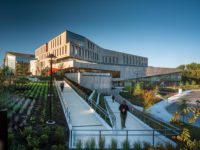Manzanita Hall makes a striking statement on the northern edge of the Arizona State University, Tempe, campus, across from the Sun Devil Stadium and blocks from the downtown. Climbing up the 15-story dormitory's curved facades is a precast structural diamond-shaped lattice that was innovative for its time—Cartmell and Rossman designed the 1967 building—and still looks radically cool. If Sally Draper, Don Draper's daughter on Mad Men, went to ASU, she probably would have lived in Manzanita, originally a women's dorm.
But the building had sentimental value and good bones—it featured the first use of post-tension concrete in Arizona when it was constructed. Initially, Manzanita's developer-manager, American Campus Communities (ACC), wanted to raze Manzanita and build new dormitories, but ASU was able to negotiate a financial scenario with ACC to support the renovation. The project's architect of record, Phoenix-based Studio MA, has had a long-standing presence on campus. Principal in charge Christiana Moss worked on ASU buildings at other firms, and Studio MA principals Dan Hoffman and Christopher Alt both taught at ASU. (For Manzanita, Studio MA worked with SCB as associate architect and Sixthriver Architects on interior design.) The dormitory reopened in the fall of 2013 to house freshmen in the College of Liberal Arts and Sciences.
To bring the building into the 21st century, Moss and her colleagues felt they had to first redo the skin, relieving the precast lattice of infill. Originally, the dorm's windows and frame walls were set into the lattice. Today, a system with alternating glass and copper-toned vertical metal panels is set back 6'12 inches from the lattice (mimicking the reddish color of the indigenous Manzanita tree's new growth). The panels help with thermal performance, and also make the pale frame pop. “To accentuate the lattice and really articulate it was part of making the building modern again,” says Moss.
This signature move almost didn't happen. When work began, the architects didn't realize that a chamfer surrounding the original windows—making them look like Superman's insignia—had also been cast into the lattice. “There was a moment [when the contractor began demolishing the first window bay], we were standing there like, 'I can't believe this,' ” says Moss. “We had to literally cut out, grind out, every single 'fillet.'”
That was a defining moment for Moss, and one that set the tone for the rest of the project. “Midcentury modern buildings should be kept modern, but how do you do that?” she asks. “You can't be timid. You can't have a preservationist view, necessarily, because it keeps them in the past. Ultimately we said, 'Let's just get in there and grind the suckers out!' ”
While Manzanita remains a residence hall, its program might as well be brand-new—student housing has changed so completely since it was built. “It's far more of a destination as opposed to a necessity,” says Curtin, of dorm life. Students want flexibility and personal space, but, most importantly, they want connection and community. In the “old” Manzanita, students complained about never encountering classmates who lived on the same hall, recalls Curtin. The architects remedied this by creating two-story lounges in the northeast leg of the Y. Each lounge serves two floors of dorm rooms. To create space for the lounges, the architects pushed out the original northeast exterior wall, just shy of two L-shaped shear walls, adding floor-to-ceiling glazing. The original muscular X-bracing of the lattice is now part of the interior, demarcating the lounge mezzanines. Kitchenettes and laundry rooms are on the lounges' lower floors, connected by a stair to the mezzanine levels, where students can watch television and relax.
To accommodate the new floor plan, which also has larger room suites lining the perimeter walls (the bed count went down in number, from 1,000 to 814), the architects had to gut the interior, including all systems. Before new plumbing risers and mechanical chases could be inserted, every penetration in the post-tensioned slabs had to be x-rayed, on every floor, says Moss. Because the post-tensioning cables were not laid out consistently on each floor, they did not align, and flexible plumbing risers were installed to account for the irregularity.
In addition to the replacement of the frame wall, the other big structural move at Manzanita was to demolish one of the four 12-inch-thick, 15-story, cast-in-place shear walls. This allowed the architects to insert two new code-compliant elevators. (Robotic demolition machines removed the walls after the building's exterior skin had been removed, in order to avoid full wind loading.) A new shear wall was then installed, 4 inches back from its original location. Studio MA and SCB also enclosed two sets of open-air stairs on the east and west sides of the building, glazing the shafts and mechanically ventilating them for required smoke evacuation.
Manzanita's lobby—just like its original dormitory floors—was isolating, dark, and uninviting, entered through a long, narrow, cast-in-place Corbusian ramp. “It was so depressing,” says Moss. She and her colleagues raised the entire surrounding plaza and created a shade canopy, whose lattice mimics the facade. To flood the lobby with daylight, they removed stucco fasciae from exterior window walls and added skylights. Inside, they exposed original terrazzo that had been buried under vinyl tile, and inserted offices, a multifunctional classroom, and a computer center, giving the lobby an airy, cheerful atmosphere.
Restoring Manzanita is in line with two of ASU's major goals, says university architect Edmundo Soltero: providing the infrastructure for a desired 100,000 students by 2020 across all campuses, and changing what had traditionally been a commuter campus into one that students call home. To do that, the campus and its buildings “have to speak to a harsh desert environment,” says Soltero. Moss agrees, noting that there is something disturbing about all-glass buildings—not an uncommon sight in Tempe—for a place where temperatures often reach 120 degrees Fahrenheit in the summer. At Manzanita, though the architects increased glazing by 15 percent, simulations showed that they are able to achieve a 12'18 percent performance increase simply by pushing the skin back from the lattice. “The R value of the original wall—we analyzed each layer—came out to 3.5. It was a real energy hog,” says Moss. Now the opaque walls have an R value of about 22.
On a recent tour of Manzanita on a 100-degree fall day, a student sat on the comfortable north-facing shade terrace, next to a sand court for volleyball and a barbeque lawn. He talked on his cell phone while music bounced softly from a sound system. The pop star Pink sang her hit “Just Give Me a Reason,” whose words seemed particularly apt for Manzanita's rebirth—“. . . We're not broken, just bent, and we can learn to love again.”
People
Architect: Christiana Moss, principal in charge; Christopher Alt, principal project architect, designer; Dan Hoffman, planning principal; Timothy Keil, project manager; Zubin Shroff, job captain
Associate Architect:
Engineers:
Consultants:
General Contractor:
Owner:
Client:
Size:
Construction Cost:
Project Cost:
Completion date: |
Products
Masonry:
Metal panels:
Curtain wall:
Glass: |

















